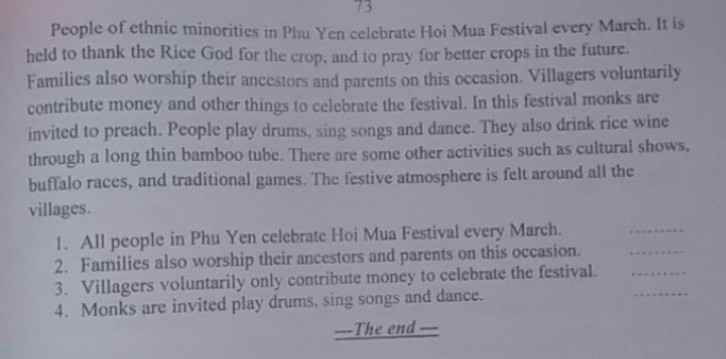II. READING COMPREHENSION (1 point / 0.25 each): Read the passage carefully and decide
whether the following statements are TRUE or FALSE
(Lưu ý:Học sinh phải viết rõ câu trả lời là TRUE hoặc FALSE,không viết tắt là T hoặc F).
There are about 3000 living languages in the world, but only six of them are the most important
ones. Two-thirds of the world’s population speaks those languages. More than 400 million people
speak English as their mother tongue. Another 400 million speak it as a second language. No one
knows how many people speak it as a foreign language. Chinese is the language with more speakers
than English, but it is only the language for more than one billion Chinese people. English is the
official language on one-fifth of the land area in the world. It is spoken in North America, Great Britain,
Australia, and New Zealand. In South Africa and India it is one of the official languages. In many
countries, the textbooks in universities are written in English. More than three-fourths of the world’s
mail is composed in English. More than three-fifths of the radio stations broadcast programs in
English. More than half of the scientific and research journals are in English. English is the language
of international communication.
Statements True False
5. Chinese is one of the most important languages.
6. 75 per cent of the world’s mail is in English.
7. People in India speak English as their second language.
8. In many countries, the textbooks in universities are written in
English
Hãy nhập câu hỏi của bạn vào đây, nếu là tài khoản VIP, bạn sẽ được ưu tiên trả lời.

25. Vietnam's national sport is Sumo_F_____
26. In sumo, a group of people face to face in a dohyo (circular ring) and push, grapple and try to throw each other__F___
27. The one who forces his opponent to the ground or pushes him out of the ring is not the winner.____F_____
28. The lifestyle of sumo wrestlers isn't normal.____T_______
29. The word 'opponent' means....
A. a person who someone is competing against in a sports event:
B. someone whose job is to teach in a school or college
C. a person who travels often, or who is travelling
D. a person who is travelling in a vehicle but is not driving it
30. The word 'they' in line four refers to
A. sumo wrestlers
B. lifestyle
C. food
D. healthy

A combination of sewage, salt, air pollution, sun, sand and wind may destroy the huge statue on the outskirts of Cairo. This statue of the sun god has the body of a lion and the face of a human being. It is five thousand years old, but it is too badly damaged to be completely saved.
The statue has already been dug out of the sad three times. However, the latest problems are much more serious. First, there are no proper drains and water pipes in the neighborhood and the underground passages round the statue have become blocked. Too much water has been running into the stone statue for several years. As a result, tiny pieces of salt have been left on the stone and have damaged it.
Secondly, air pollution from the increasing amount of traffic in Cairo is also destroying the ancient statue. The air is so full of poisonous gases that it is making the stone crumble and decay even faster.
Thirdly, the statue is being damaged by extremes of temperature. For example, although the air is very cold at night, during the day the stone of the statue becomes very hot under the strong sun. Other natural forces such as serve sandstorms also attack the statue.
Finally, the tourists who visit the statue everyday also cause a lot of damage.
1. The statue is in the center of Cairo. False
2. Part of the statue looks like a lion and part like a person. True
3. The underground passages round the statue are full of waste and water. True
4. High temperatures damage stone far more than low temperature. No Given
5. Fortunately, little damage is caused by visitors to the statue. False

1 T
2 F
3 T
4 T
1 True
2 False
3 True
4 True